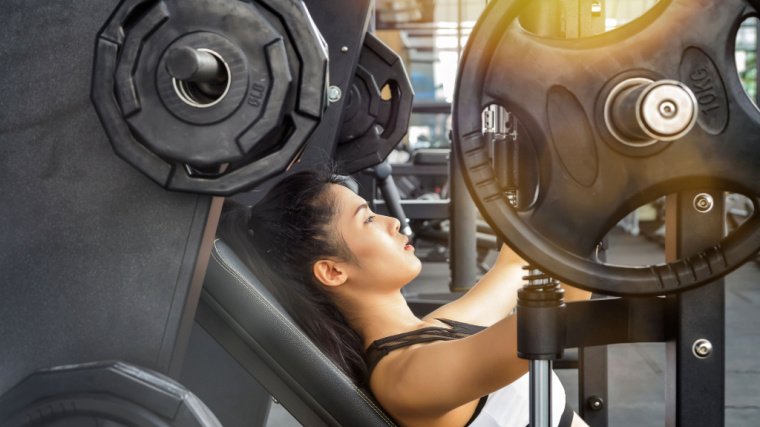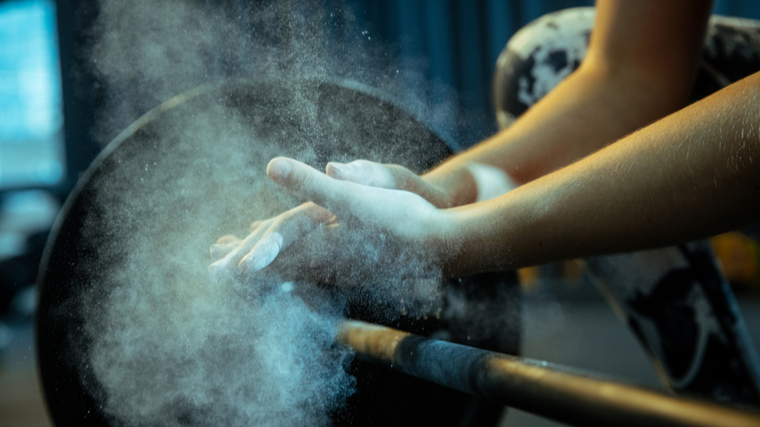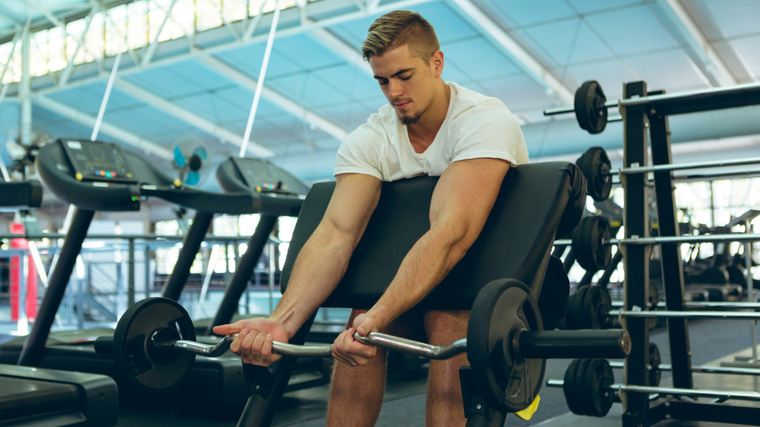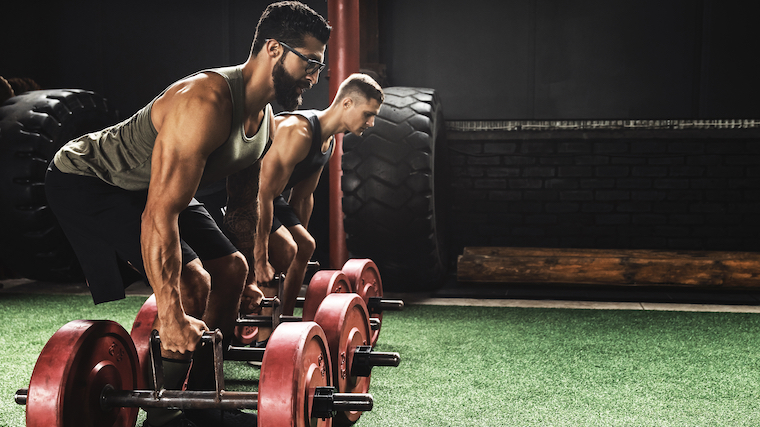In your lifting journey, you’ve almost certainly seen someone bench pressing from a decline, neutral, or incline bench. You’re probably also familiar with snatch-grip deadlifts or changing grips on your pull-ups and lat pulldowns.
You might also be familiar with the concept of adjusting your exercise angles — without even knowing it.

If you’re a bodybuilder, changing your exercise angle can help you hit different parts of your muscles, by activating different, smaller muscle fibers. When you’re training for strength, changing the angle can help you get stronger in different directions. Read on to learn more about exercise angles and muscle fibers, and the best options to play around with them in your program to reap the benefits.
- What Is Exercise Angle?
- How Much Does Exercise Angle Matter?
- The Best Exercises to Manipulate Exercise Angle
- How to Program Different Exercise Angles
Editor’s Note: The content on BarBend is meant to be informative in nature, but it should not be taken as medical advice. When starting a new training regimen and/or diet, it is always a good idea to consult with a trusted medical professional. We are not a medical resource. The opinions and articles on this site are not intended for use as diagnosis, prevention, and/or treatment of health problems. They are not substitutes for consulting a qualified medical professional.
What Is Exercise Angle?
Changing the angle from which you push or pull the weight will change the position of your muscles, bones, and tendons. That will cause your muscles to need to work in a different way, and activate different muscle fibers.
[Read More: The Best Upper Body Exercises and Workouts]
Similarly, changing your stance in a squat or deadlift will change the angle of your ankle and knee joints. This can be helpful for accommodating mobility restrictions, as well as training more muscle fibers and incorporating different — and sometimes larger — ranges of motion.
Body Position
You can change your exercise angle in a few ways. For bench pressing, you can change the angle of the bench and press from a declined, neutral, or inclined position. This adjusts the angle of your body’s position. Although you’ll still be pressing straight up, your body’s angle can produce a different emphasis in your muscles.
Movement Angle
You can also change the angle from which you perform the actual movement. When pulling from a cable machine, you can adjust your stance to do a standing single-arm pulldown from a 45-degree angle.
If you normally stand underneath and pull from a 90-degree angle, you’re changing the angle that the cable actually moves through. Your muscles will work to stabilize your body to perform the pull from the new angle.
How Much Does Exercise Angle Matter?
When following a training program, you’ll notice that the volume, load, intensity, and frequency will gradually change over time. In order for progressive overload to occur, it’s important to change other variables, including the exercise angle.
Range of Motion and Hypertrophy
One way to change your exercise angle is to train the same exercise through different ranges of motion. If you train a smaller range of motion, you’re also making your exercise angle smaller. Think about the 1 ¼ squat. While you perform the first squat to (maybe) your full depth, you then do an additional ¼ of a squat before coming back up. Just because it’s not your full range, doesn’t mean it’s not still effective.
A study on the effect of range of motion on hypertrophy during resistance training showed that while training the full ROM is most beneficial to lower body exercises, they’re only more beneficial to a certain degree. (1) Partial ROM exercises also stimulate muscle growth. Studies on upper body exercises produced mixed results. (2)
Isometric Angles and Strength Gain
Exercise angles can also be manipulated in isometric exercises. You can level up your plank by elevating your feet, for example. Research has shown that angle changes do seem to positively impact strength increases for isometric exercises. (3) That’s not to say you can’t get your gains without changing your angles — but you might want to try those subtle angle changes for extra strength.
Exercise Angles and Hypertrophy
Research hasn’t definitively found that changing your exercise angle alone has a direct impact on hypertrophy. So if you’re looking for a bigger “upper chest,” you don’t want to solely depend on incline presses to get you there.
However, many studies have shown that changing multiple variables over time to create progressive overload — and continuously challenge yourself — is necessary to see results (4). If you can’t change your angles, you can continue changing other variables.
The Best Exercises to Manipulate Exercise Angle
To alter your exercise angle, you’ll be changing either the angle of your body or the direction that the weight moves away from your body. For each major muscle group, here are some of the best exercises to do and how to change up their angles.
Changing the angles can help you reach a greater range of motion and address mobility issues. For smaller upper body muscles, you can get specific and change your angle to train a smaller muscle fiber. If you’re an overhead athlete in a sport like baseball, training multiple angles can help your shoulders stay strong and prepared.
- Leg Exercise Angles
- Back Exercise Angles
- Chest Exercise Angles
- Shoulder Exercise Angles
- Arm Exercise Angles
- Core Exercise Angles
Leg Exercise Angles
Legs (and glutes): quite a dominant set of muscle groups. No matter your goals, you’re probably getting in your squats, deadlifts, and lunges on leg day. Here are some ways to change your exercise angle for some of your big leg exercises.
Squat Exercise Angles
Try a barbell front squat to change the angle of your torso in a squat. For folks who have a difficult time keeping their torso upright due to limb length or other mobility restrictions in back squats, the position of the barbell here helps you to engage your core and stay up. You can play with changing your foot stance as well if you’re trying to squat deeper.
Deadlift Exercise Angles
Sumo deadlifts allow you to pull heavier from a larger range of motion. Stepping your feet out wide apart will change the angle of your knees to ankles. You’ll get more quad activation and work your adductors, too.
You can also try pulling from a deficit to change the full angle of your body related to the weight. You’ll get a bigger stretch in your hamstrings and overall more work there, too.
Lunge Exercise Angles
When you lunge, can you get both knees to bend to 90 degrees? Try stepping your feet a bit wider apart to give your ankles more room.
You can also change the angles completely with a side lunge. You’ll be working in the frontal plane (side-to-side). For functional training into everyday life, it’s beneficial to be strong, mobile and able to dodge and maneuver on one leg.
Back Exercise Angles
For a strong, powerful back you’re likely doing plenty of vertical and horizontal pulls, both up and down. Since your back consists of many smaller muscle groups, changing your exercise angles can help target different areas by using the same exercise.
Pull-Up Exercise Angles
Choosing your exercise angle is all about the principle of specificity — what are you trying to achieve? By changing the angle of your arms to your back, wide-grip pull-ups are often more difficult than close grip. A wider grip recruits more work from your lats. If you’re training your back, you’ll get the most bang for your buck.
However, maybe you want to work more on the smaller muscles around your spine and shoulders. In that case, close-grip pull-ups might be better.
Lat Pulldown Exercise Angles
In lat pulldowns, similar guidelines apply as with the pull-up when changing your grip. You can also manipulate your cables to do a single-arm, neutral-grip lat pulldown for some unilateral training. Play with the angle by changing your grip and distance from the weight to strengthen some of your smaller muscles.
Row Exercise Angles
The TRX row is a great exercise to slowly change your exercise angle as you get stronger. Beginners will start with their body farther away from the ground, a greater angle between their torso and the floor.
To progress and increase difficulty, walk your feet more forward so your body comes closer to parallel with the floor. With a smaller angle between the back of your body and the ground, you have a longer way to pull yourself up. This can also be progressed to an inverted row.
Chest Exercise Angles
When training your chest, the angle of your body can change which parts of your pecs you are hitting. Bodybuilders may want to take advantage of exercise angles here to really see their pecs grow and pop. But regardless of aesthetics, you will likely find yourself wanting a strong, balanced chest for optimal function and strength.
Bench Press Exercise Angles
The flat bench press is a very important compound exercise that works not only your chest, but back and shoulders, as well. For a balanced, strong, and defined chest, it can be beneficial to play with the exercise angle of the bench press by simply adjusting the bench.
Decline bench press may shift some of the emphasis toward your lower pectoral muscles. The incline bench press, conversely, can shift some stress toward your upper pectoral muscles. You can also try the incline bench press with dumbbells and play with the angle of your grip.
There are different degrees of both decline and incline that will work certain areas more than others. You can continue to progress your chest work while staying with this important movement in your program.
Shoulder Exercise Angles
For shoulder exercises, think of exercises that have your scapula and gleno-humeral joints working together. Changing the angle can help to relieve discomfort or restrictions, as well as build strength and muscle in different directions.
Dumbbell Press Exercise Angles
You can change the exercise angle of the overhead press by using dumbbells and adjusting the placement of your arms. Keeping your elbows bent at 90 degrees, you can keep your forearms perpendicular and out to your sides for a wide grip press.
Alternatively, keep your elbows bent with your wrists stacked over them. Narrow the angle by bringing your elbows slightly towards each other. This brings your shoulders to about 45 degrees.
You can continue to close the angle by coming all the way to a neutral grip. Finding the right spot between that wide grip and neutral grip can help you move at your most optimal position.
Barbell Overhead Press Exercise Angles
Changing the grip of your overhead press with a barbell can also help you hit different mobility ranges in your shoulders. Try close and wide grips to play around with what works best.
Arm Exercise Angles
Your arms consist of your biceps, triceps, and brachialis (forearms). You can change the exercise angle for exercises in each of these to hit smaller muscle fibers and see your strength gains carry over to your main lifts.
Biceps Curl Exercise Angles
When you do a barbell biceps curl — or perform the same move with dumbbells — you can target the long head of your biceps by using a close grip. Or, widen your grip to emphasize the short head of your biceps.
[Read More: Our Favorite Forearm Workouts, + the Best Forearm Exercises]
You can also change the exercise angle by switching the position of your hands. Try a prone grip for a reverse curl to target your forearms. These will strengthen your wrists as well and help you build grip strength. Hammer curls — performed with a neutral grip — will emphasize your biceps short head and your forearms.
Triceps Extension Exercise Angles
You can change the angle on your triceps extensions to hit all three heads of your triceps. Rope pushdowns will hit the short head of your triceps, whereas overhead triceps extensions might more effectively take your triceps long head through a full range of motion.
You can change the angle here by facing the cable machine, leaning forward, and pulling the rope overhead. Then, push up to straighten your arms.
Core Exercise Angles
When training your core, think of holistically strengthening and building all the muscles, both deep and superficial. There are many variations to sit-ups and other core moves. By playing with these exercises, you can produce more all-encompassing results, getting stronger from all angles.
Plank Exercise Angles
Try to resist all forms of spinal movement when training your core. In that way, you’ll be incorporating different angles of your body to target different muscles. A classic anti-extension exercise is a plank. Planks will hit all of your core muscles, and you can play with the angle by elevating your feet on a bench.
Pallof Press Exercise Angles
A Pallof press is an anti-rotation core exercise that will also work your arms, chest, and back. Resisting movement from side to side will fire up your obliques. Change the angle by half kneeling, tall kneeling, or standing. Play with which direction you press the cable away from you to get some extra arm work. You can also train the rotation movement with cable chops and lifts, and change up the angle with the position of your arms.
Farmer’s Carry Exercise Angles
For an anti-lateral flexion exercise, try one of many variations of the farmer’s carry. You can do this with a single arm — a suitcase carry — to resist side bending.
Change the angle of the weighted arm by carrying the weight by your side, in a racked position, or overhead. Your whole core will fire up to stabilize your spine, getting anti-flexion, anti-extension, and anti-rotation work in at the same time.
How to Program Different Exercise Angles
So you chose a new angle for your bench press — now what? Like all variables, when changing your exercise angle, you should have an intention and goal in mind for doing so. You’ll want to leave it in your program with progressive overload long enough to see results, but continue to change it gradually as you progress.
How Often to Alter Exercise Angles
Depending on your goal, training cycles and periodization work well when you program anywhere from six to 10 weeks at a time. Whatever you do, you want to do it consistently.
Maybe you’ve been doing wide-grip pulldowns for a while. If you want to try close-grip pulldowns to target goals, throw them in your program for at least six to 10 weeks, varying the volume to progress.
When to Alter Exercise Angles
You can change your exercise angles every six to 10 weeks, but you don’t need to. Sometimes one training cycle isn’t enough time, and you want to keep working on a specific angle for another cycle.
You can stay with the same angle but continue to vary your sets, reps, load, or rest time. If you’re recovering from an injury and resting a certain muscle, consider trying another angle option until you’re ready to go back to the first one. Listen to your body, or consider hiring a professional coach to help you make the best programming decisions.
Angling for Gains
If you’re angling for more gains, you might want to consider altering your exercise angle. But as much as any other variable in your program, the effectiveness of your exercise angle changes depend on what you’re trying to do and why.
Changing the angle of your exercises allows you to target different parts of your muscles and build strength, stability, and mobility in multiple directions and ranges of motion. If you’ve got a reason to do it, try it out and see what you can gain.
References
1. Kubo K, Ikebukuro T, Yata H. Effects of squat training with different depths on lower limb muscle volumes. Eur J Appl Physiol. 2019 Sep;119(9):1933-1942.
2. Schoenfeld BJ, Grgic J. Effects of range of motion on muscle development during resistance training interventions: A systematic review. SAGE Open Med. 2020 Jan 21;8:2050312120901559.
3. Lanza MB, Balshaw TG, Folland JP. Is the joint-angle specificity of isometric resistance training real? And if so, does it have a neural basis? Eur J Appl Physiol. 2019 Dec;119(11-12):2465-2476.
4. La Scala Teixeira CV, Evangelista AL, Pereira PEA, Da Silva-Grigoletto ME, Bocalini DS, Behm DG. Complexity: A Novel Load Progression Strategy in Strength Training. Front Physiol. 2019 Jul 3;10:839.
Featured Image: Alliance Images / Shutterstock





